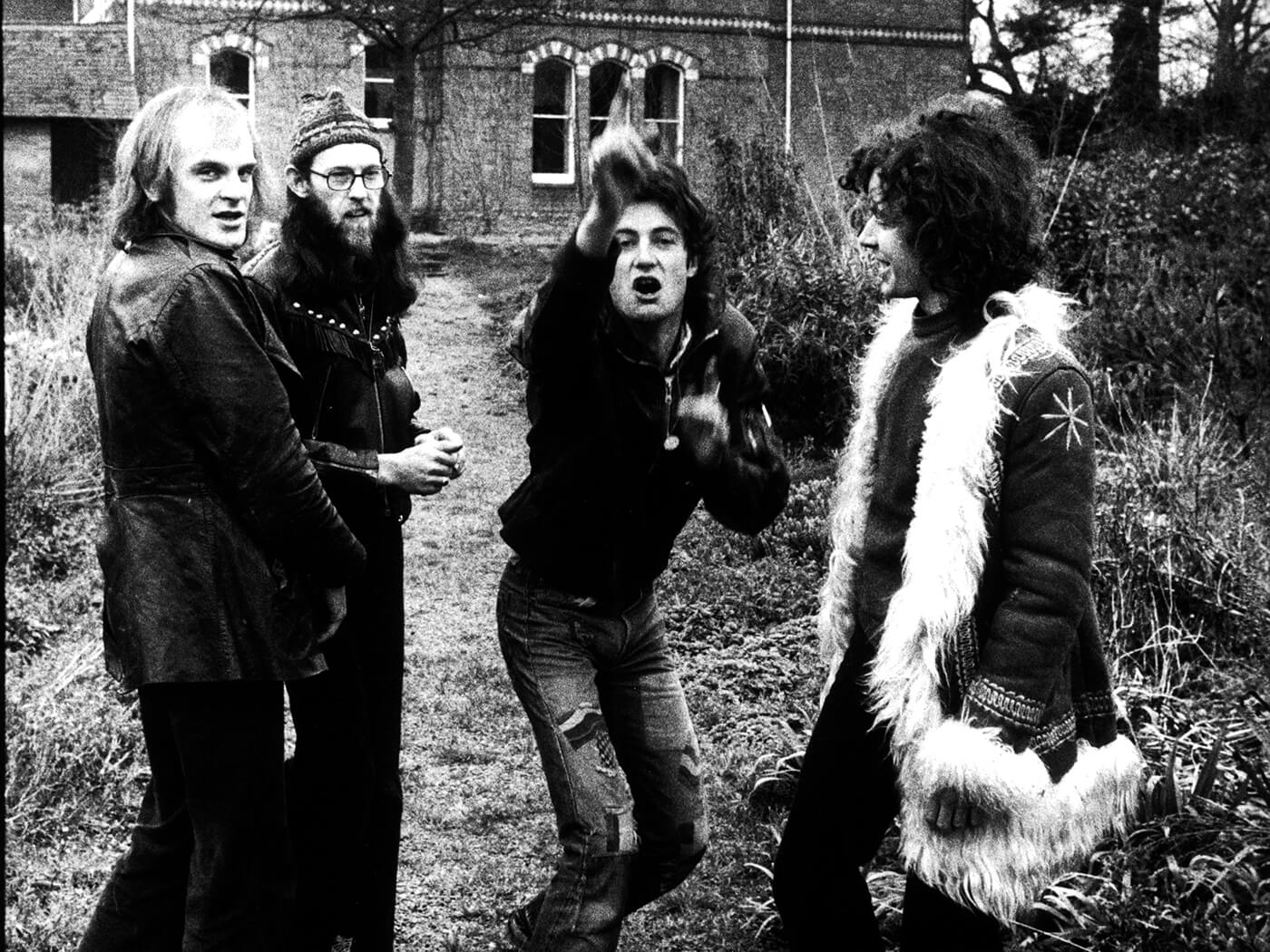As Mark E Smith once told Peter Hammill, it wasn’t Van Der Graaf Generator’s lyrics that sparked his love for the band, or the specifics of their music, nor even their academic complexity. It was the sheer power of the thing that drew him in. “He said, ‘You just have to go with the power,’” recalls Hammill today. “And I agree with that. Mark did like an aspect of noise, something Van Der Graaf have always liked. Sometimes that’s just noise brutality, and sometimes it’s noise in the musique concrète style.”
Even Van Der Graaf Generator’s detractors would be hard-pressed to deny their intensity. Here was a four-piece with often no electric guitar or bassist, just drums, organ (plus bass pedals), saxophone and a singer issuing the most infernal noises –choirboy coos, banshee wails and demonic grunts – from his slender frame. “He does seem like a normal person,” organist Hugh Banton said of Hammill in a 2016 issue of Uncut, “but evidently he isn’t…”
Formed as an R&B outfit in Manchester at the height of psychedelia, they soon began to concoct a menacing, very European mix of the avant-garde, curdled folk music, angular rock and operatic drama. The constant was chaos – in the tumult of Guy Evans’ savage drumming, in David Jackson’s electronically processed saxophones and especially in Hammill’s untutored guitar and keyboard playing, an elemental counterpoint to Banton’s scholarly skills on the organ. That Charisma allowed them to make such a mess unhindered was certainly heroic, if not fiscally wise.
They reformed in 2005 for a fruitful final act, but here, collected for the first time across 18 hours, 122 tracks and a disc of video performances, is Van Der Graaf’s original voyage, a stop-start revolution beginning with hippie-ish sci-fi balladry and concluding with a live album that predicted the weirdest post-punk.
We begin with February 1970’s The Least We Can Do Is Wave To Each Other, opener Darkness (11/11) confidently floating in on spacey organ and wind noise. Very Floyd, and yet the Syd-less group themselves were just finding their feet in early 1970, while Genesis and Yes were still stumbling around. Perhaps the only group who’d already made a classic prog record were King Crimson. It’s apt, then, that one section of the 11-minute After The Flood echoes the manic rush of 21st Century Schizoid Man and that Robert Fripp would guest on December’s H To He, Who Am The Only One, and 1971’s Pawn Hearts.
The latter is one of their masterpieces, three deranged tracks of vaulting ambition and strangeness. Twelve-minute opener Lemmings (Including Cog), especially, is a gloriously ugly delicacy that must have sent less adventurous listeners rushing back to the shop to return their LP. Man-Erg begins as a grand piano ballad, before a thoroughly cacophonous section appears like sludge rising to a lake’s surface. By the end of the song, the two sections are being played simultaneously. Back Street Luv this was not. Pawn Hearts peaks with the side-long A Plague Of Lighthouse Keepers. A modular tale of death, despair and redemption, it’s highly experimental, including one part where 16 Van Der Graafs play different songs at once.
Such inspired madness chimed with the mood across Europe in the days of the Baader-Meinhof group and Brigadi Rossi. The group were frequently met by riots on the Continent, on one occasion driving their van through the glass wall of a venue to escape the mob. All this intensity led to a temporary split, and when Godbluff appeared in 1975, things were very different. Hammill, his hair shorn, was now playing electric guitar or violent clavinet, and the group were recording live, with none of the cut-up complexity of their previous work. Here were four long songs, tortuous and brutal, led as always by Hammill’s crooning and screeching. “From what tooth or claw does murder spring?” he bellows on The Sleepwalkers. “From what flesh and blood does passion?” At times his performances on Godbluff suggest David Bowie under the sway of the demonic forces he’d been drawing pentagrams to banish, though Diamond Dogs’ Sweet Thing/Candidate/Sweet Thing (Reprise) suggests the flow of influence went only one way.
1976’s Still Life was a quieter affair, the title track informing us that death, though awful, is at least preferable to eternal life, “ultimately bored by endless ecstasy”. After the tepid World Record – Meurglys III, a reggae-tinged epic about Hammill’s favourite guitar, is not their finest 21 minutes – Banton and Jackson left the band, no longer able to survive the financial penalty of being so uncompromising. Things could have gone very wrong for Van Der Graaf then, with punk’s dust cloud appearing on the horizon, but the next two years saw a brave move further towards pummelling noise that put them in step with the coming storm. 1977’s The Quiet Zone/The Pleasure Dome seems to invent Muse, while ’78’s Vital, an in-the-red live set with John Lydon in the crowd presumably picking up tips for PiL, is a highlight of the box, a distorted medley of …Lighthouse Keepers and The Sleepwalkers, white-hot.
Sprinkled among these album tracks are radio sessions – including an amusing Top Gear interview in which Hammill reveals that an early member left to join blues-rockers Juicy Lucy, and an electrifying Peel session from the Godbluff era. Other treats include an early studio version of Killer, a first mix of Theme One, and The Boat Of A Million Years, a typically breezy B-side about Ra’s solar barque.
Live In Rimini 1975 is worthwhile, mainly because it includes the Hammill solo tracks (In The) Black Room… and A Louse Is Not A Home, intended for the scrapped Pawn Hearts follow-up, but the quality is grainier than a ’70s macrobiotic diet. Much better is a crystal-clear 1976 set from Paris’ Maison Mutualite, one of the classic lineup’s last stands. They’re tight, especially on the closing Killer and Man-Erg, but there’s always a sense that they’re teetering on a knife edge – that chaos, again.
Though it’s not new material per se, the jewels in the box are the four new stereo remixes of their core albums, H To He…, Pawn Hearts, Godbluff and Still Life, which enhance the clarity and sense of space in the music. H To He…’s Killer and The Emperor In His War Room are fuller, more vibrant, while A Plague Of Lighthouse Keepers reveals new instrumental layers and improves the crossfades between sections. Godbluff is alternately harder hitting and more intimate: during the hushed intro of The Undercover Man, it’s as if Hammill is right there whispering in your ear, the type of hallucinatory voice that so often afflicts his damaged protagonists.
The Charisma Years isn’t a revelatory box – there are only a few gems here that haven’t already been brought to light elsewhere, notably the Parisian live set. It is, though, a comprehensive survey of a revelatory group. Listened to in the wrong mood, Van Der Graaf Generator can sound ridiculous, the lyrics overdone, the distorted saxes painful, Hammill’s astounding vocals too extreme; but, entered into wholly, this is music with a gnomic power, that can incite riots and assorted psychic disturbances. As Mark E Smith would attest, that power is hard to resist.

